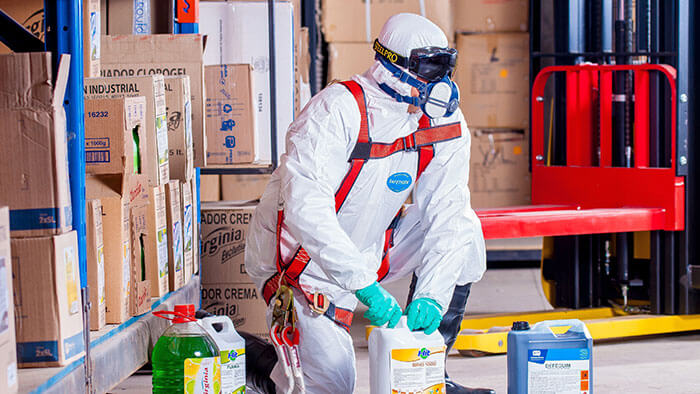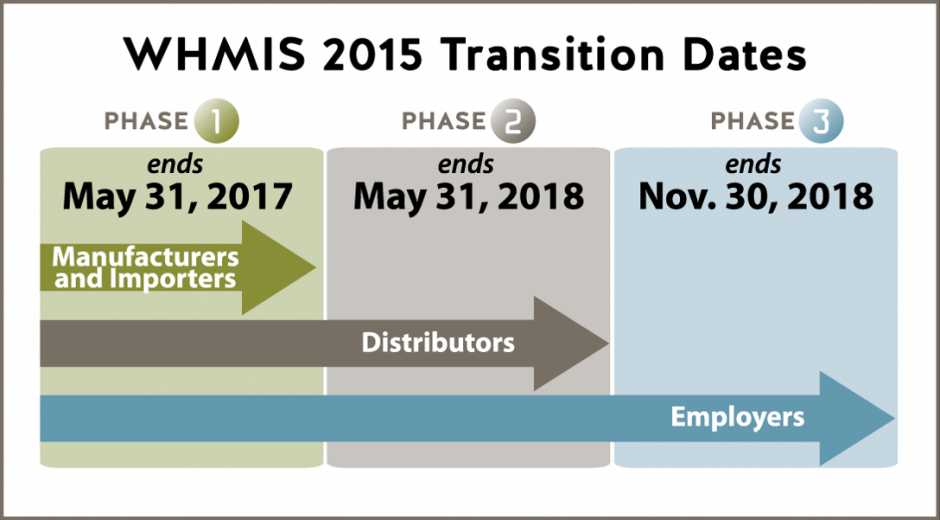One of the benefits of living at work… err… I mean, working from home is that there just magically seems to be more hours available to me in my workday!
I am no longer confined to the rigour of the 8-4 or 9-5; my workstation is in my living room.
As such, I have found myself spending more and more time dwelling on the crucial questions in life, like application of occupational health and safety regulations, than other less pressing concerns… like what the family is doing – come on, don’t judge – some of us just need a break from them in lockdown.
All jokes aside, I have finally had time to unravel what I already knew.
WHMIS in our workplace is only part of our chemical safety program.
Now hold on just a minute, don’t let your eyes glaze over just yet… hear me out.
WHMIS is what we refer to when we are thinking about chemical hazards in our workplace, but in reality, it is only a regulation, specifically Ontario Regulation 860.
Upon inspection, I am sure your JHSC will find products in your workplace that have consumer labels on them. So that begs the question, are they exempt from the employer’s obligations under WHMIS?
Short answer, not exactly. Long answer, read on!

To get a complete picture of what must be considered is found in the Occupational Health and Safety Act, Part IV Toxic Substances, specifically S. 37 titled “Hazardous material identification and data sheets.” It reads:
“An employer, (a) shall ensure that all hazardous materials present in the workplace are identified in the prescribed manner; (b) shall obtain or prepare, as may be prescribed, a current safety data sheet for all hazardous materials present in the workplace; and (c) shall ensure that the identification required by clause (a) and safety data sheets required by clause (b) are available in English and such other languages as may be prescribed.”
Now you may be thinking, yup, WHMIS, and you would be mostly correct. But what stands out for me is the term “hazardous material“.
So, bear with me for a minute; it’s about to get convoluted. Now, a “hazardous material” is listed in the OHSA, and as a result, the prescribed controls have to be put in place; enter WHMIS.
Looking at Ontario Regulation 860, also known as the WHMIS regulation, you need to read section 2, which states, “Every hazardous product is designated as a hazardous material.”
Now we have a new term to follow, “hazardous product“.
Well, a quick google search will show you we have another layer of law on our hands, the federal Hazardous Product Act, 1985.
It defines a hazardous product as “any product, mixture, material or substance that is classified in accordance with the regulations made under subsection 15(1) in a category or subcategory of a hazard class listed in Schedule 2.”
So by now, I’m am sure you are thinking, so I follow just WHMIS and that? Oh no, there’s more. We have more layers of this onion to peel.
The Hazardous Products Act section 12
Restrictions on application
This Part does not apply in respect of the sale or importation of any
- (a) to (c) [Repealed, 2014, c. 20, s. 113]
- (d) nuclear substance, within the meaning of the Nuclear Safety and Control Act, that is radioactive;
- (e) hazardous waste, being a hazardous product that is sold for recycling or recovery or is intended for disposal;
- (f) and (g) [Repealed, 2014, c. 20, s. 113]
- (h) tobacco or a tobacco product as defined in section 2 of the Tobacco and Vaping Products Act;
- (i) manufactured article; or
- (j) anything listed in Schedule 1.
So what is this Schedule 1 they speak of just above? At this point, I’m thinking, if anything, you will need to know what Schedule 1 is – at least for closure on this epic saga we have embarked on together! It reads:
SCHEDULE 1 (Paragraph 12(j)) Non-Application of Part II
- Any pest control product as defined in subsection 2(1) of the Pest Control Products Act
- Any explosive as defined in section 2 of the Explosives Act
- Any cosmetic, device, drug or food, as defined in section 2 of the Food and Drugs Act
- Any consumer product as defined in section 2 of the Canada Consumer Product Safety Act
- Any wood or product made of wood
Boom, there we have it, another law to look at! The Canada Consumer Product Safety Act. Because hey, we are really seeing what the employer’s obligations are concerning those consumer products in your workplace.
In the interest of saving a little time, I’ve taken out the highlights for us. The Canada Consumer Product Safety Act states:
“an article to which this Act or the regulations apply means: a consumer product; anything used in the manufacturing, importation, packaging, storing, advertising, selling, labelling, testing or transportation of a consumer product; or a document that is related to any of those activities or a consumer product.”
Just to be 100% accurate here, it defines a “consumer product” as “a product, including its components, parts or accessories, that may reasonably be expected to be obtained by an individual to be used for non-commercial purposes, including for domestic, recreational and sports purposes, and includes its packaging.”
So, out of all of this, what should you walk away with thus far?
Consumer products fall under different rules than the traditional supplier-provided controlled products we find in our workplaces. They are designed to be sold to the general public for use in our homes.
Inevitably though, they will also find their way into our workplaces for various reasons, including the quantity used, the frequency of use, perhaps even the price.
What we will find in terms of labelling requirements is really the only difference.
The Canada Consumer Product Safety Act states the requirements for their labels because they are listed as exempt from the Hazardous Products Act.
The Hazardous Products Act covers hazardous products, which WHMIS deems to be hazardous materials, which are then listed as controlled by the requirements of the OHSA.
Either way, you slice this pie – we are looking at chemical hazards in the workplace.
What has to be considered is YOUR organization’s chemical safety program.
What substances are allowed to be used in your workplace, and by whom? What substances are prohibited from your facility, and how do you monitor that? Does your training cover the contents of both WHMIS 2015 requirements and consumer products if present?
If so, do not forget the S.37 obligation for SDS for consumer products!
An employer’s obligation to provide information about all hazards in the workplace is found in the OHSA S.25 (2) (d). It states that
“an employer shall acquaint a worker or a person in authority over a worker with any hazard in the work and in the handling, storage, use, disposal and transport of any article, device, equipment or a biological, chemical or physical agent.”
It doesn’t say subject to which labelling system there now does it? It says “any.”
So if the chemical hazard is present, a worker must be adequately trained; there is no consumer product exemption for that.
To be honest, if you spent as much time as I just did looking for quasi-loopholes, we could more or less agree that that practice is not good faith health and safety.
Hopefully, after reading this, WHMIS just got a whole lot cooler in your eyes!, but if this was a bit too much for you, remember here at IST, we legitimately find this neat, reach out if you have questions.
My manager [email protected] is a bigger nerd than I am with this stuff!
Until next time.
Geoff Rowatt | CHRL
Safety Trainer, Industrial Safety Trainers

